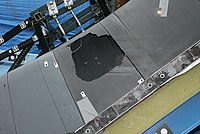
Photo from wikipedia
Marine concrete structures are subjected to a harsh environment and potential climate change variables. Deterioration of the structure demands drastic measures for repair and rehabilitation. Advanced composite materials exhibit unique… Click to show full abstract
Marine concrete structures are subjected to a harsh environment and potential climate change variables. Deterioration of the structure demands drastic measures for repair and rehabilitation. Advanced composite materials exhibit unique advantages compared to conventional construction materials. Over the years, carbon fiber reinforced polymer (CFRP) composite material has been used widely for the repair and rehabilitation of structures. Many studies have been conducted on the performance of FRP flexural strengthened reinforced concrete (RC) members. Still, experimental studies investigating the performance of shear strengthening under real environmental conditions are lacking. This paper helps fill this gap because it is an experimental investigation of the behavior of CFRP shear strengthened RC beams under a marine environment. Specimens were exposed to cyclic (wet/dry) and full exposure to the elements for a 3-month period. Six strengthened beams and one unstrengthened beam were tested; the tested control beam failed due to a diagonal-tension crack. The increase in the concrete shear capacity of the strengthened specimens was in the range of 14–18% compared to the control beam. Thus, the results lead to the conclusion that CFRP strengthening increases the shear capacity of specimens considerably.
Journal Title: International Journal of Geomate
Year Published: 2017
Link to full text (if available)
Share on Social Media: Sign Up to like & get
recommendations!